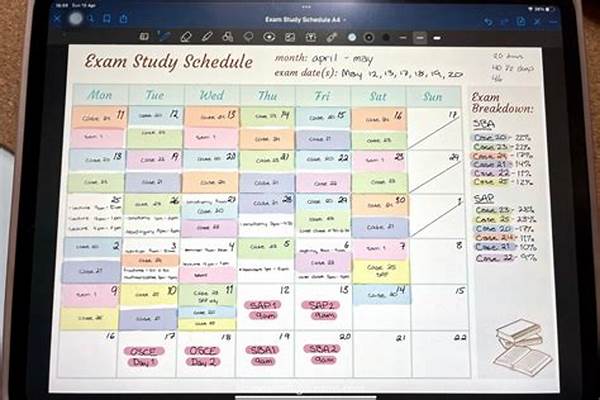H1: How to Plan Study Schedules That Stick
Read More : The Link Between Exercise And Study Focus
In today’s fast-paced world, creating a study schedule that sticks can feel as elusive as capturing lightning in a bottle. Many students find themselves overwhelmed by academic pressures, extracurricular commitments, and sometimes, the tantalizing lure of procrastination. Crafting the perfect study plan isn’t just about time management—it’s about forming a strategy that aligns with your goals and lifestyle. To plan study schedules that stick, one must go beyond generic time-blocking techniques and adopt personalized tactics that cater to individual learning styles and productivity patterns.
Imagine this: You sit down at your desk, with the noble intention of smashing through your to-do list, but a funny cat video grabs your attention. Minutes turn into hours, and before you know it, your study time has evaporated. This scenario is all too common, highlighting the importance of a reliable schedule designed specifically for you. Having a personalized plan can enable you to manage your time effectively, reduce stress, and ultimately, improve academic performance.
The process of planning study schedules that stick involves reflection, creativity, and flexibility. Students often struggle with structure, not due to a lack of effort, but because they haven’t crafted a schedule that reflects who they truly are. By understanding your habits, peak productivity hours, and personal commitments, you can design an engaging and sustainable study routine. In the following sections, we will delve into techniques, tools, and tips that can transform your study routine from chaotic to composed.
Crafting a Study Schedule that Works
First, you must assess your current study patterns. Are there particular times during the day when you feel most energized? Use these moments to tackle challenging subjects. Conversely, during low-energy periods, focus on easier tasks. Recognize your attention span and schedule breaks to avoid burnout. Regular breaks not only refresh the mind but are proven to boost concentration and mood. The Pomodoro Technique, which involves 25 minutes of focused work followed by a 5-minute break, is one method to enhance productivity.
Secondly, set realistic goals. Rather than overwhelming yourself with ambitious targets, break down tasks into manageable chunks. This makes it easier to track progress and maintains motivation. It’s essential to celebrate small victories along the way, as these little achievements can reinvigorate your drive to continue.
Thirdly, utilize technology to your advantage. There are numerous apps designed to aid in scheduling and time management, such as Google Calendar, Trello, or Notion. These tools can send reminders, help prioritize tasks, and track daily progress. Color-coding tasks according to urgency or subject may also provide a clear visual representation and ensure important tasks are not overlooked.
Lastly, remain adaptable. Life is unpredictable, and rigid schedules can lead to frustration and failure. If an unforeseen event disrupts your plan, don’t stress. Flexibility is key in maintaining a positive attitude toward studying. Adjust your schedule as needed and reflect weekly on what works or what needs tweaking.
H2: The Benefits of a Successful Study Schedule
Having a well-structured study schedule does wonders beyond academics. It fosters discipline, enhances time-management skills, and boosts self-confidence. As you learn to manage your time better, you’ll find more opportunities to indulge in hobbies, social activities, or relaxation without the burden of impending deadlines. This holistic approach promotes a healthier and happier student lifestyle, empowering you to excel in all spheres of life.
—Descriptive Section for How to Plan Study Schedules That Stick
When it comes to mastering the art of planning study schedules that stick, many people find themselves bogged down by the sheer thought of time management. However, constructing a solid study schedule doesn’t have to be a daunting task. Let’s transform this preconceived notion with some humor, warmth, and a healthy dose of practical guidance. In this journey, we will unravel the science and art behind creating a study routine that feels less like a chore and more like an empowering tool towards achieving academic excellence.
Our narrative begins with the age-old problem faced by students globally: the battle against procrastination. Almost every student has experienced the scenario where their intention to study is thwarted by the cute distraction of a viral video or the enticing call of a social media notification. The trick to overcoming this universal plight lies in understanding “how to plan study schedules that stick,” which involves a profound understanding of one’s habits and inclinations.
Research suggests that the human brain is conditioned to respond well to structured routines. However, the key to making a schedule stick is customization. A one-size-fits-all approach often falters because it doesn’t cater to individual uniqueness. For instance, some students are early birds, catching the proverbial worm with their dawn productivity; others find their muse in the twilight hours. By identifying your natural rhythm, you can schedule high-energy tasks during periods when you’re most alert and focused.
H2: Personalizing Your Study Schedule
Personalization is the secret sauce. When you tailor your study schedule to reflect your lifestyle, interests, and energies, studying becomes an engaging endeavor instead of a marching requirement. Are you a visual learner? Incorporate mind maps and diagrams into your study sessions. Does music fuel your brain’s engine? Play some instrumental tracks to keep you company as you conquer that calculus. The idea is to build a conducive environment that facilitates learning.
It’s not just about personal preferences; it’s also about understanding when the world around you is most conducive to studying. If you need silence, study when your house is at its quietest. If you thrive on social interaction, form a study group where you can exchange ideas and insights. The freedom of personalization empowers you and keeps the study plan relevant and sustainable.
H3: Tools and Techniques for Successful Study Schedules
While personalization lays the groundwork, the implementation of various tools and techniques can bolster the effectiveness of your study schedule. Calendar apps like Google Calendar help structure your day, while task management tools such as Trello and Asana keep track of pending assignments. Implementing the Eisenhower Box—a decision-making matrix—enables you to prioritize tasks effectively, ensuring urgent and essential tasks are always addressed first.
Moreover, discover techniques such as spaced repetition, where information is reviewed at increasing intervals, or batch studying, which involves focusing on one particular subject or type of task for a period before switching, minimizing the cognitive load. Variety in study sessions not only keeps boredom at bay but also optimizes brain engagement, contributing significantly to retention rates and understanding.
Adopt these approaches with the flexibility they deserve. Life is unpredictable, and the ability to shift gears without derailing your entire schedule is invaluable. Pitfalls and pitfalls are expected, and the true measure of success is how you adapt and learn from them rather than succumb to them.
—Summaries Related to How to Plan Study Schedules That Stick
Purpose of Building Study Plans
The primary goal behind devising study schedules that stick is to transform the learning process into a streamlined and enjoyable journey. When schedules are designed with individual preferences and capacities in mind, they transcend beyond routine and become an integral part of a balanced life. This personalization promotes an environment where academic responsibilities do not overpower personal happiness, leading to a more fulfilled and productive learner.
Achieving success with study plans involves cultivating habits and discipline that extend beyond academia. The skills gained—such as effective time management, prioritization, and adaptability—are invaluable life skills that serve individuals well into their professional lives. By creating a sustainable study routine, students can effortlessly juggle academic pressures, personal commitments, and leisure activities, reducing anxiety and enhancing overall quality of life.
Moreover, a well-thought-out study schedule builds self-esteem and empowers individuals to take charge of their educational endeavors. As students experience the fruits of their planned labor, their confidence surges, bolstering their resolve to tackle even more ambitious academic pursuits. Ultimately, the goal is not merely academic success but the holistic development of an individual capable of achieving balance in all aspects of life.
H2: Key Elements for Successful Study SchedulesH3: Integrating Tools and Techniques—Discussion on Planning Study Schedules
When embarking on the quest to understand how to plan study schedules that stick, it is vital to acknowledge the multifaceted nature of this task. In an era where distractions are but a click away, maintaining focused study sessions becomes a formidable challenge. The good news? This challenge is surmountable with the right mix of strategy, technology, and mindset.
Let’s delve deeper into the psychological aspects of effective study planning. The mind craves order and predictability. Designing a study schedule that mirrors one’s unique cognitive blueprint can work wonders in enhancing learning efficiency. Techniques such as the Pomodoro Technique are brainchild inventions tailored to intertwine rest and study, closely mimicking the brain’s natural attention spans and recuperative needs. This method accentuates the importance of breaks, illustrating how structured downtime can boost overall productivity.
H2: Understanding the Appeal of Structured Study
Embracing structure seems paradoxical in a society that increasingly values flexibility. Yet, structure within schedules serves as a reassuring guide that helps reduce decision fatigue and optimize mental energy. By pre-deciding study times, students save mental bandwidth, which can then be redirected towards creative problem-solving or deep learning.
H3: Incorporating Flexibility Within Routine
Surprisingly, building flexibility into a structured environment is not only possible but beneficial. Life’s unpredictability is the eternal variable in any schedule, and accounting for flexibility in advance equips students to pivot gracefully rather than succumb to stress. This adaptability transforms a good study schedule into a resilient one, keeping it active and effective even amid life’s inevitable upheavals.
Guided by flexibility and structure balance, achieving productivity is not just a distant dream—it’s an attainable, sustainable reality. For students and professionals alike, mastering the art of planning study schedules that stick is an empowering step in their educational lives.
—Illustrations on How to Plan Study Schedules That Stick
In the realm of academic achievement, the power of a well-planned schedule is primarily underestimated. But, by injecting creativity, strategy, and personalization into this process, students can revolutionize their approach to education. No longer will study be a burden—it becomes a symbiotic ally in the quest for knowledge. Moving beyond rigid timelines, effective study schedules liberate students, enabling them to enjoy both their scholarly pursuits and personal adventures. An art form, indeed, and one worth mastering for any educational journey.
—Short Article on How to Plan Study Schedules That Stick
Crafting a study schedule that not only captures your current workload but also sticks with you through the ups and downs of busy academic seasons requires more than just determination; it demands a thoughtful approach. When one sets out to learn how to plan study schedules that stick, the journey is as insightful as the destination.
The allure of a fail-proof schedule lies in personalization. Knowing when and how you work best is the first step. Each student operates differently under various circumstances. Are you a night owl with creative bursts at midnight, or does your brain clock in with the first light of dawn? Acknowledging these natural rhythms allows you to schedule demanding tasks during peak times of alertness and simpler revisions during more relaxed periods.
H2: Navigate Distractions with Ease
Distractions are the bane of any well-intentioned student. The secret to sidestepping them lies in creating a conducive study environment free from unnecessary interruptions. Tools like ambient sound apps or instrumental playlists can help maintain focus. Meanwhile, establishing a designated study space can psychologically prepare the mind for learning. The trick is to associate certain environments with productivity, thereby making focus an uncompromising habit.
H3: How to Stay Flexible
A ‘plans change’ ethos is intrinsic to maintaining longevity with your scheduling strategy. The ability to adapt without a hitch when unexpected events crop up is a testament to a well-rounded plan. Incorporating buffer times or catch-up sessions into your schedule permits an ease of transition while maintaining the integrity of your study objectives.
Ultimately, achieving the ideal study schedule provides a strong foundation that weaves education seamlessly into your life, reducing stress and boosting confidence as academic performance climbs. As with any new skill, practice and reflection are key, turning tentative strategies into lifelong learning habits.


